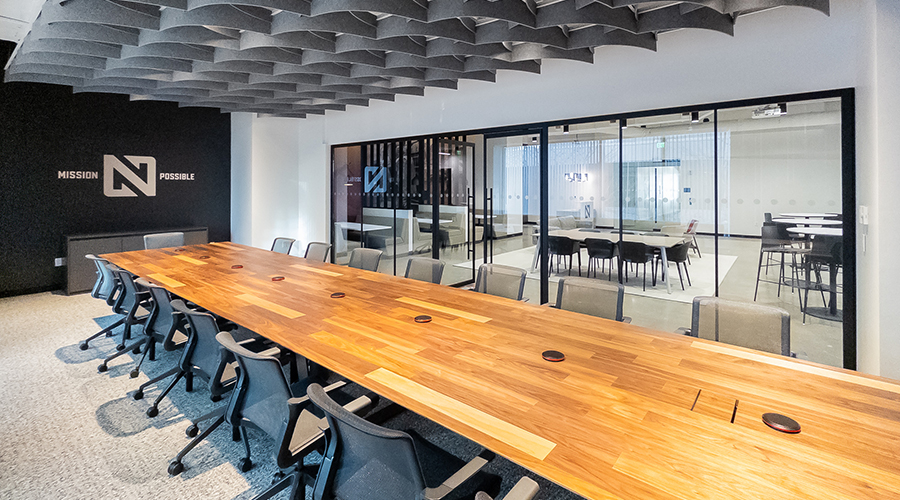Prescription for Training
Barnes-Jewish Hospital meets the challenges of high-tech building systems and equipment with a rigorous, multi-layer training program
Operating on the cutting edge of building technology is a balancing act. New or redesigned space outfitted with state-of-the-art systems and equipment can mean increased efficiency and productivity, with less down time and emergency repairs. But it also means that the old ways of approaching maintenance won’t work.
The facilities staff at Barnes-Jewish Hospital (BJH) in St. Louis faces the challenges of selecting and maintaining brand-new technology in an ever-changing environment.
“The most challenging aspect of my job the last few years has been keeping up with the leaner budgets and technological advances in equipment,” says Dave Eveland, supervisor of the major mechanical shop at BJH. “We have to do our work much smarter these days.”
For BJH’s plant operations and maintenance department, working smarter includes training supervisors and front-line technicians to maintain buildings that contain both age-old challenges and the latest in high-tech equipment and systems.
High-profile Challenges
BJH is the flagship hospital of BJC HealthCare and the largest hospital in Missouri, a result of the 1996 merger between Barnes Hospital and the Jewish Hospital of St. Louis. It is also the primary adult teaching hospital of Washington University School of Medicine, one of the top medical schools in the country.
The BJH system includes 35 buildings, the oldest built in 1915 and the most recent completed in 2002. The buildings contain 6.5 million square feet of space, with the main campus covering four city blocks. Due to the consolidation, the hospital is in the midst of a 10-year, campus-wide integration and renovation project.
“We are constantly renovating,” says Mike Menzel, manager of plant operations and maintenance for BJH. “Plan review and construction coordination are a large portion of our daily operation. It is no longer just maintenance and repair.”
Two new buildings were recently added to the department’s roster: the Southwest Tower, which houses the 52,000-square-foot Charles F. Knight Emergency and Trauma Center and which will soon have two floors of operating rooms and three floors of research laboratories; and the 14-story, 645,000-square-foot Center for Advanced Medicine.
The next major construction project will focus on creating the new operating rooms in the Southwest Tower and renovating existing operating rooms located in another building.
Staffing Considerations
BJH has 9,030 employees, 157 of whom work in the facilities engineering department — as trades people, managers, support staff and engineers — to maintain the hospital. The department is made up of seven shops — major mechanical, electrical, general maintenance, carpentry, paint, HVAC/R and plumbing, each with a supervisor and lead person supervised by Menzel.
The ongoing construction has greatly reshaped department operations.
“There are approximately 35 construction projects ongoing at any one time,” Eveland says. “These consist of minor remodeling to complete renovations. The construction mainly affects us by having to provide manpower to do utility interruptions for contractors and, of course, new equipment to maintain.”
The major mechanical shop maintains more than 1,000 pieces of equipment, including pumps, compressors, medical air and vacuum systems, operating room (OR) equipment, food-service equipment, and housekeeping equipment.
The hospital also has added new systems during construction, including a building-automation system (BAS) that allows the department to monitor critical equipment 24 hours a day, seven days a week, with minimal manpower.
For example, a sterilizer that is in use around the clock is fully automated piece of critical equipment. It is computer-controlled and linked via modem to the shop computer and the manufacturer’s computer. Other automated equipment tied into the BAS include the domestic water pumps, which have variable-speed drives complete with internal modems, and the medical air and vacuum systems — all critical equipment that needs constant monitoring by the BAS.
The department also implemented a new computerized maintenance management system (CMMS) three years ago. To complement the CMMS, the department developed a Web-based interface that allows customers to track the progress of requested repairs.
And that’s not all.
“Our focus in the last couple of years has been toward commissioning of our systems and buildings to better understand how to invest our precious capital dollars in the future,” Menzel says.
Focus on Training
With every new system or piece of equipment come new challenges.
“With current budgets consistently getting leaner and with new technology arriving almost daily, we need to concentrate on keeping our mechanics trained and their skills honed to be the very best they can be,” Eveland says. “Basically, we like to get a person that has been trained in mechanical skills to some degree, and then we train them or have them trained to maintain the specialized equipment that our shop is responsible for.”
Technicians are expected to have two years of formal technical training in a shop specialty before they are hired. That training is augmented after hiring with off-site training in job-specific areas, such as medical gas pipefitting and welding, OR table maintenance and sanitizer maintenance.
Eveland says equipment manufacturers or vendors still provide most of the training his crew receives because the hospital uses a wide variety of specialty machines. But he has figured out a way to customize the training further and to ensure that his team is well rounded.
“We also have weekly in-service training that I have my mechanics conduct,” he says. “I assign them a subject, and they do research, make handouts or manuals, and give the class — very informal but very informative.”
BJH also offers an in-house program to prepare members of the facilities department for the demands of management positions. The program, called Learn Today, Lead Tomorrow, builds on the skills of the department.
First, Menzel says, the department sends supervisors for each shop for trained provided by American Society for Healthcare Engineering to be managers. Training focuses on thorough knowledge the requirements of the Joint Commission on Accreditation of Healthcare Organizations (JCAHO), the hospital accreditation agency. This training helps ensure that supervisors understand the latest in JCAHO requirements and preventive-maintenance recommendations, which seem to multiply as square footage grows and awareness rises of issues such as indoor-air quality.
Next, volunteers from among the trainees develop the in-house management training for employees who want to work their way up through the ranks at BJH.
Participants learn budget development, project development and review, and capital expenditures planning. They also participate in a mentoring program involving other departments with which facilities staff must work, such as housekeeping and security. Each supervisor spends two weeks in the mentoring program, learning the challenges faced by other departments and sharing issues faced by facilities teams. And they share ideas, processes and programs that might help other departments.
“We have encouraged the supervisors participating in the program to apply for other internal manager jobs to utilize the skills they have developed through the program,” Menzel says. “We have been successful in placing a supervisor in a manager’s position at one of our smaller hospitals.
“The program has now been offered to the faculty hourly staff members to prepare them for a promotion to a supervisor or lead person within our organization. No promises, just the opportunity to advance if they so desire.”
Balancing Act
Menzel says training and other personnel issues have become some of his primary concerns. Because fewer people are getting into the facilities maintenance field, those who do need more comprehensive technical training every year, he says.
Then there is human nature, which becomes an issue in organizations as large as BJH.
“It seems with 142 different personalities all working together that we never solve all of the issues that come up in a day-to-day operation, and people problems are very difficult to correct,” Menzel says. “I’ll take a mechanical problem any time over a personnel issue.”
The shops seem to pull together to get the jobs done as needed and, most importantly, support the mission of the hospital. In 2002, BJH earned perhaps the toughest recognition of all: the 2002 Consumer Choice award in National Research Corp.’s Healthcare Market Guide, a ranking that is based on consumer perceptions of a healthcare organization’s quality and image.
Related Topics:











